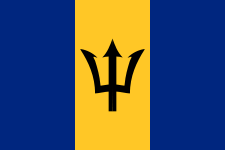Flag of Barbados
The national flag of Barbados was officially adopted on 30 November 1966, the island's first Independence Day. It consists of a triband of two bands of ultramarine, which are said to stand for the ocean; separated by a golden middle band, representing the sand on the island. A black trident-head (commonly called the "broken trident"), is centred within the golden band. The trident symbol was taken from Barbados' colonial badge, where the trident is shown with Britannia holding it. The broken lower part symbolises a symbolic break from its status as a colony.[1] The three points of the trident represent the three principles of democracy – 1) government of, 2) for, and 3) by the people.
The design for the flag was created by Grantley W. Prescod and was chosen from an open competition arranged by the Barbados government. Over a thousand entries were received.[2]
The official British Standard colour code numbers for the flag are:
Ultramarine — BCC 148, Gold — BS O/002.[3]
-
-
Royal Standard of Barbados
See also
References
External links
|
|---|
| | Sovereign states | |
|---|
| Dependencies and
other territories | |
|---|
|
|
|---|
| | National flags | |
|---|
| | National coats of arms | |
|---|
|


